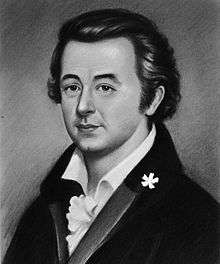Pál Kitaibel

Pál Kitaibel (3 February 1757 – 13 December 1817) was a Hungarian botanist and chemist.
He was born at Mattersburg and studied botany and chemistry at the University of Buda. In 1794 he became Professor and taught these subjects at Pest. As well as studying the flora and hydrography of Hungary, in 1789 he discovered the element tellurium, but later gave the credit to Franz-Joseph Müller von Reichenstein (1740–1825) who had actually discovered it in 1782.
Together with Franz de Paula Adam von Waldstein (1759–1823), he wrote Descriptiones et icones plantarum rariorum Hungariae ("Descriptions and pictures of the rare plants of Hungary"; M. A. Schmidt, Vienna, three volumes, 1802–1812). In this work he made the first description of Nymphaea lotus f. thermalis.[1]
He died in 1817 at Pest.
The genus Kitaibelia[2] of mallows was named after him by Carl Ludwig von Willdenow.
Species named after him:
- Ablepharus kitaibelii [3]
- Cardamine kitaibelii
- Kitaibela vitifolia
- Knautia kitaibelii
- Aquilegia kitaibelii
References
- ↑ Veler, Ana (November 2008). "Nymphaea lotus up north, naturally". Water Gardeners International. Bucharest, Romania. 3 (4). Retrieved 9 August 2014.
- ↑ http://www.malvaceae.info/Genera/Kitaibelia/gallery.html
- ↑ Beolens B, Watkins M, Grayson M. 2011. The Eponym Dictionary of Reptiles. Baltimore: Johns Hopkins University Press. xiii + 296 pp. ISBN 978-1-4214-0135-5. ("Kitaibel", p. 142).
- ↑ IPNI. Kit.